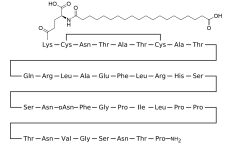NN is explicit that fibrils do form in cagrilintide, in both that research paper and in the patent. I have quoted those sections extensively across these threads. In the research paper, yes, they use a test that puts it in relatively extreme conditions vs. what is going to be seen after it is reconstituted by most people here, but we don't know what it looks like on the manufacturing side, how roughly it is treated there, how it is stored, etc. The patent filing uses a significantly less torturous test, but we still see fibril formation in the longer term with that test as well.
Part of the testing in the paper is to determine if fibrils are formed. I have never claimed this makes it dangerous - I have explicitly said I do not understand enough about the science to know if these fibrils truly are dangerous. What I will say is that in the testing conditions in the paper and the patent filing, they do find that cagrilintide produces fibrils.
You're writing a whole lot that doesn't actually say anything one way or other about the concern. No one is arguing that the PH remains low in your body.
No one has produced details on what PH is being used for the single chamber pen - we seem to be assuming it is a higher PH, and I wouldn't be surprised if that is the case, but they might also be going with a lower pH for the entire solution, unless someone has evidence that semaglutide is harmed at the lower pH.
Again, the patent involves a significantly more gentle test, at temperatures below 100F and just doing 100 end-over-end inversions of the vial on the liquid form of cagrilintide + buffering agent each day.
I've also been quite explicit my primary point is we have no idea what is happening with the manufacturing before the lyophilization. How long was it in the pre-lyophilized state? What pH was it manufactured at and stored at in between? What were the conditions during that time period? If I thought that just reconstituting it at a lower pH solved all ills, I would be using cagrilintide myself - I'm certainly confident in my ability to lower the pH of a solution. All I've said about it in reconstituted form is that if I had decided to press on and use it regardless of the rest, I would filter it and reconstitute at a lower pH to do what I could to prevent further fibril formation.
From the paper on Oral Semaglutide:
https://www.accessdata.fda.gov/drugsatfda_docs/nda/2019/213051Orig1s000ChemR.pdf
"Semaglutide tablets are co-formulated with 300 mg of salcaprozate sodium (SNAC, a
permeation enhancer). The isoelectric point of the semaglutide is 5.4. The peptide has a
low solubility at pH range 2-6. Semaglutide is considered a BCS class 4 molecule (low
permeability and low solubility). It is hypothesized that SNAC facilitates the oral
absorption of semaglutide in stomach either by transiently increasing the transcellular
permeability in gastric epithelium or through buffering action on the local environment
near the site of action to provide a high pH and thereby protecting the semaglutide from
degradation."
Additionally:
There are numerous treatment options currently available for patients with type 2 diabetes mellitus; however, a multitude of patients continue to have inadequately controlled glycemic levels with their current antihyperglycemic regimen. Furthermore, ...

pmc.ncbi.nlm.nih.gov
"The effect of pepsin on oral semaglutide stability was most profound at low pH, with oral semaglutide being most labile toward pepsin at pH 2.6 (t½ = 16 min)" Its clear that Semaglutide is unstable at low PH and will degrade quicker, making storing it in a low PH solution not ideal.
So there you go as far as your question about how we can say they likely aren't lowering the PH of the CagriSema mixture. Especially since the custom designed Cagri to be soluble and long term stable in a pH up to 8.
Again, no, part of the paper was not to find if fibrils form in cagri this is already a-given, as the chemical type that is the basis of Cagri will fibrillate. The whole point of the experiment was to find the best chemical composition that resisted fibrillation the longest and best while providing the best effect and any other sought after qualities. These tests would be used to simulate the maximum amount of degradation the product could possibly experience in its good til shelf life.
It is a false equivalence to say that because Cagri CAN fibrillate, then it DOES fibrillate. This is simply not true.
NN is not going to open itself up to liability of long term health effects caused by there drug because they figured it "probably wouldnt be a problem" they have a duty to test to the fullest extent and guarantee individuals safety. Not to mention the class action lawsuits that could and would happen if it became obvious they had shipped a product that can and will degrade and harm you during its shelf life.
As far as manufacturing concerns, there is only one way to create the specific formulation that is cagrilinitide, that's kind of how chemicals work. Any sort of impurities will come up in a purity test from janoshik, and if the chemical is wrong it wont match the sample that janoshik or any other testing party uses.

